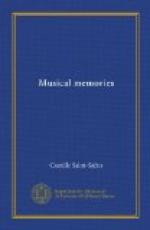I went to Hugo’s evenings as often as possible, for I never could drink my fill of the presence of the hero of my youthful dreams. I had occasion to note to what an extent a fiery republican, a modern Juvenal, whose verses branded “kings” as if with a red hot iron, in his private life was susceptible to their flattery. The Emperor of Brazil had called on him, and the next day he could not stop talking about it constantly. Rather ostentatiously he called him “Don Pedro d’Alcantara.” In French this would be “M. Pierre du Pont.” Spanish inherently gives such florid sounds to ordinary names. This florid style is not frequent in French, and that is precisely what Corneille and Victor Hugo succeeded in giving it.
A slight incident unfortunately changed my relations with the great poet.
“As long as Mlle. Bertin was alive,” he told me, “I would never permit La Esmeralda to be set to music; but if some musician should now ask for this poem, I would be glad to let him have it.”
The invitation was obvious. Yet, as is generally known, this dramatic and lyric adaptation of the famous romance is not particularly happy. I was much embarrassed and I pretended not to understand, but I never dared to go to Hugo’s house again.
Years passed. In 1881 a subscription was taken up to erect a statue to the author of La Legende des Siecles, and they began to plan celebrations for its dedication, particularly a big affair at the Trocadero. My imagination took fire at the idea, and I wrote my Hymne a Victor Hugo.
As is well known, the master knew nothing at all about music, and the same was true of those around him. It is a matter of conjecture how the master and his followers happened to mistake some absurd and formless motif for one of Beethoven’s sublime inspirations. Victor Hugo adapted the beautiful verses of Stella to this halting motif. It was published as an appendix in the Chatiments, with a remark about the union of two geniuses, the fusion of the verse of a great poet with the admirable verse of a great musician. And the poet would have Mme. Drouet play this marvellous music on the piano from time to time! Tristia Herculis!
As I wanted to put in my hymn something peculiar to Victor Hugo, which could not possibly be attributed to anyone else, I tried to introduce this motif of which he was so fond. And, by means of numerous tricks which every musician has up his sleeve, I managed to give it the form and character which it had lacked.
The subscription did not go fast enough to suit the master, and he had it stopped. So I put my hymn in a drawer and waited for a better opportunity.
About this time M. Bruneau, the father of the well-known composer, conceived the idea of giving spring concerts at the Trocadero. Bruneau came to see me and asked me if I had some unpublished work which I would let him have. This was an excellent occasion for the presentation of my Hymne, as it had been written with the Trocadero in mind. The performance was decided on and Victor Hugo was invited to come and hear it.




